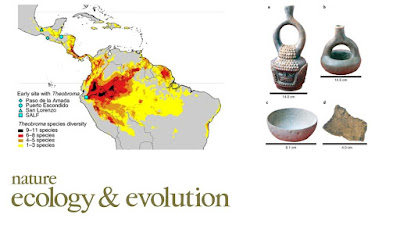.
The use and domestication of Theobroma cacao during the mid-Holocene in the upper Amazon
Zarrillo et al.
The use and domestication of Theobroma cacao during the mid-Holocene in the upper Amazon
Zarrillo et al.
Cacao (Theobroma cacao L.) is an important economic crop, yet studies of its domestication history and early uses are lim- ited. Traditionally, cacao is thought to have been first domesticated in Mesoamerica. However, genomic research shows that T. cacao’s greatest diversity is in the upper Amazon region of northwest South America, pointing to this region as its centre of origin. Here, we report cacao use identified by three independent lines of archaeological evidence—cacao starch grains, absorbed theobromine residues and ancient DNA—dating from approximately 5,300 years ago recovered from the Santa Ana-La Florida (SALF) site in southeast Ecuador. To our knowledge, these findings constitute the earliest evidence of T. cacao use in the Americas and the first unequivocal archaeological example of its pre-Columbian use in South America. They also reveal the upper Amazon region as the oldest centre of cacao domestication yet identified.
Locations of the four archaeological sites in Mexico, Central America and South America with the earliest evidence of Theobroma use, as well as the species diversity distributions for the genus Theobroma 17,19,58 . The zone surrounding SALF has six known native species of Theobroma: T. bicolor; T. sinuosum; T. speciosum; T. subincanum; T. stipulatum; T. glaucum 58 . The species diversity map is derived from ref. 17 and is modelled using species observations extracted from GBIF 58 . We reduced the modelled continuous 1–11 species diversity range of Thomas et al. 17 to four categories: 1–3, 4–5, 6–8 and 9–11 species.
.
.











No hay comentarios:
Publicar un comentario